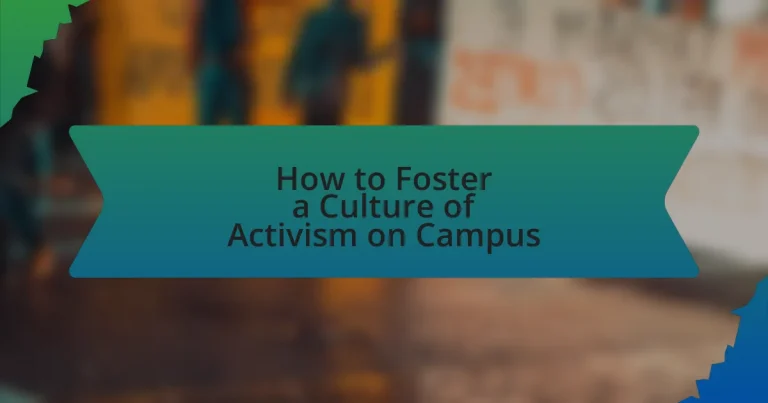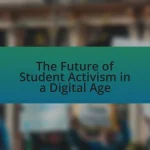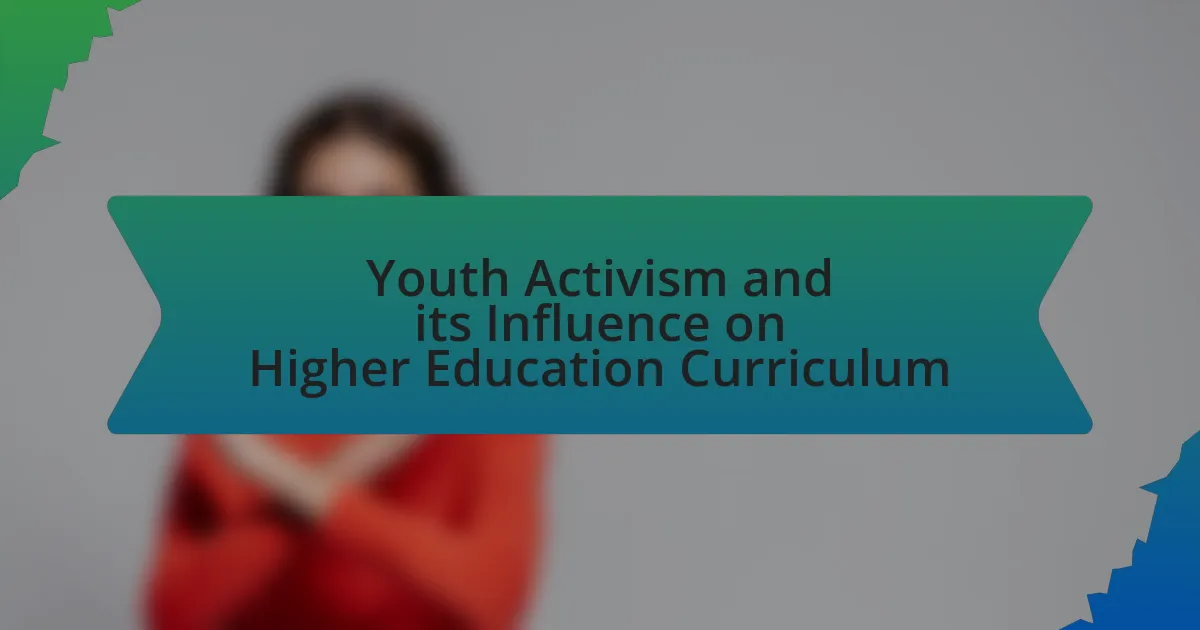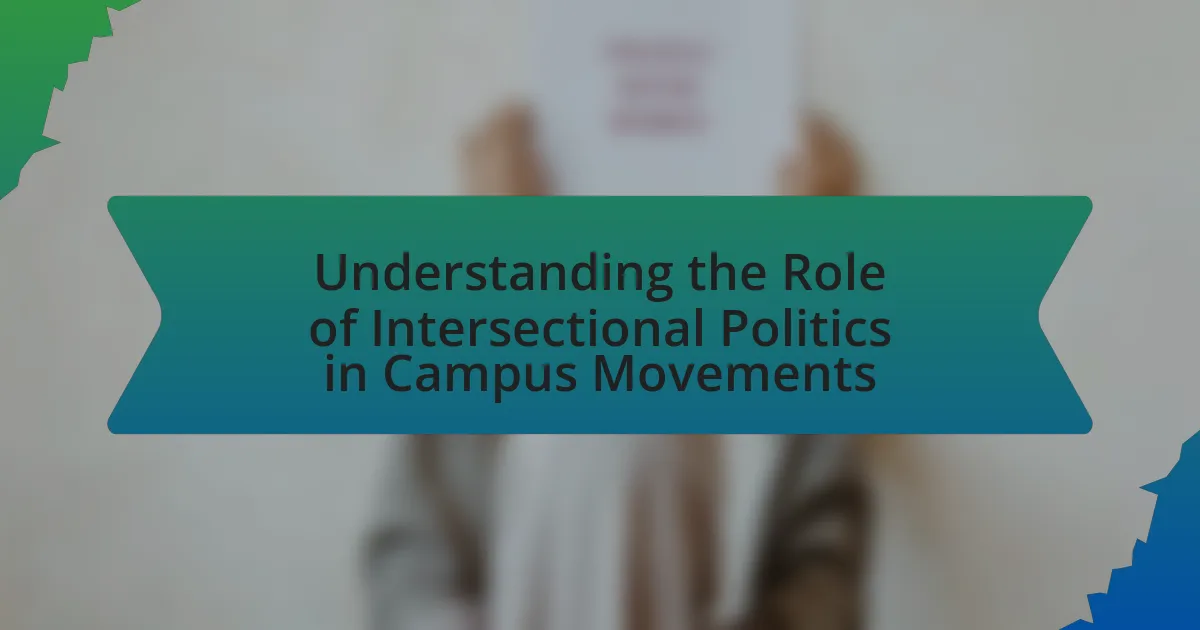Fostering a culture of activism on campus involves creating an environment that encourages student engagement in social, political, and environmental issues. This article explores the importance of activism for college communities, highlighting its role in promoting civic engagement and personal development. It examines historical contexts that have shaped campus activism, key elements of a vibrant activist culture, and the significant roles played by student organizations, faculty, and administration. Additionally, the article addresses challenges faced by activists, strategies for initiating movements, and practical tips for enhancing activism through collaboration and effective communication, particularly utilizing social media.
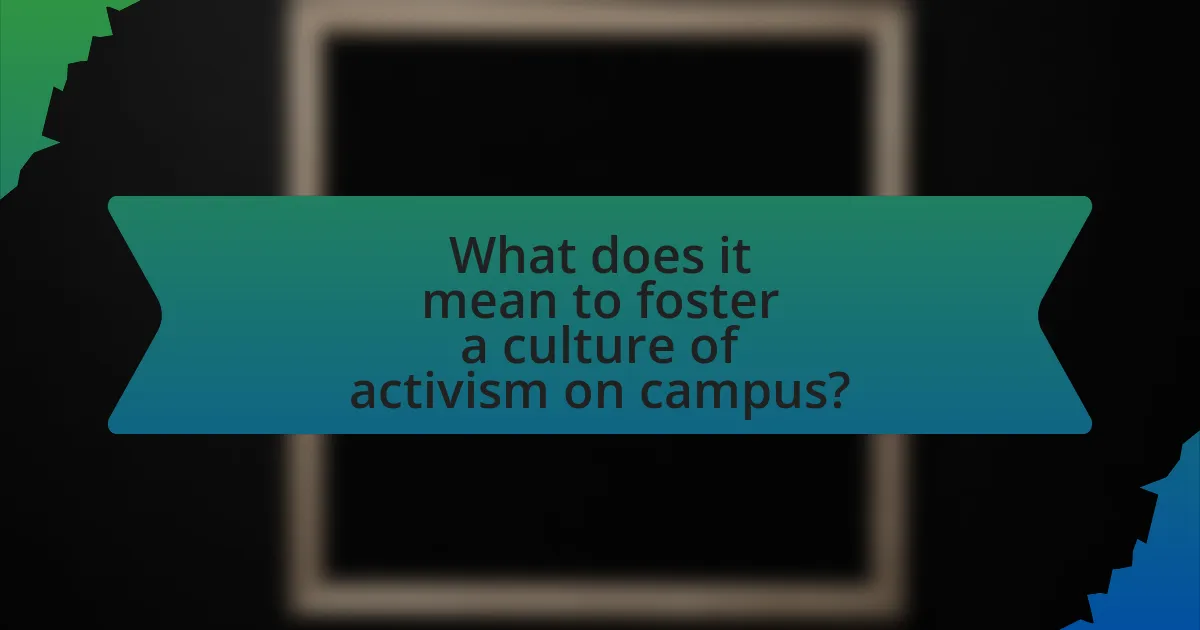
What does it mean to foster a culture of activism on campus?
Fostering a culture of activism on campus means creating an environment that encourages students to engage in social, political, and environmental issues actively. This involves providing resources, support, and opportunities for students to express their views, organize events, and participate in advocacy efforts. Research indicates that campuses with strong activist cultures often see higher levels of student engagement and civic participation, as evidenced by studies showing that students involved in activism are more likely to vote and participate in community service.
Why is fostering activism important for college communities?
Fostering activism is important for college communities because it encourages civic engagement and social responsibility among students. Active participation in social issues helps students develop critical thinking skills and a sense of agency, which are essential for their personal and professional growth. Research indicates that students involved in activism are more likely to become engaged citizens, with studies showing that 70% of college activists continue to participate in civic activities post-graduation. This engagement not only enriches the college experience but also contributes to a more informed and active society.
What historical contexts have shaped activism on campuses?
Activism on campuses has been shaped by various historical contexts, including the civil rights movement, anti-war protests, and the feminist movement. The civil rights movement of the 1960s mobilized students to advocate for racial equality and social justice, exemplified by events like the Student Nonviolent Coordinating Committee’s sit-ins. Anti-war protests during the Vietnam War era galvanized student activism against military involvement, leading to significant demonstrations, such as the Kent State shootings in 1970, which highlighted the consequences of dissent. Additionally, the feminist movement has influenced campus activism by addressing gender equality and reproductive rights, with organizations like the Women’s Liberation Movement emerging in the late 20th century. These historical contexts have collectively fostered a culture of activism that continues to evolve on campuses today.
How does activism contribute to student development?
Activism contributes to student development by enhancing critical thinking, fostering leadership skills, and promoting social responsibility. Engaging in activism encourages students to analyze complex social issues, articulate their viewpoints, and collaborate with diverse groups, which cultivates their ability to think critically and solve problems. Research from the Higher Education Research Institute indicates that students involved in activism report higher levels of civic engagement and leadership skills compared to their peers who are not involved. This involvement not only prepares students for future roles in society but also instills a sense of responsibility towards their communities, ultimately shaping them into informed and active citizens.
What are the key elements of a vibrant activist culture?
A vibrant activist culture is characterized by community engagement, inclusivity, and effective communication. Community engagement fosters a sense of belonging and collective action, as seen in successful movements like the Civil Rights Movement, where grassroots organizing played a crucial role. Inclusivity ensures diverse voices are heard, enhancing the movement’s strength and reach; for instance, the Women’s March in 2017 highlighted intersectionality by bringing together various marginalized groups. Effective communication, both online and offline, facilitates the dissemination of information and mobilization of supporters, as evidenced by the use of social media in recent climate strikes. These elements collectively create an environment where activism can thrive and effect change.
How do student organizations play a role in activism?
Student organizations play a crucial role in activism by mobilizing students around social, political, and environmental issues. These organizations provide a platform for collective action, enabling students to organize events, campaigns, and discussions that raise awareness and advocate for change. For instance, the Student Environmental Action Coalition has successfully led initiatives that resulted in universities adopting sustainable practices, demonstrating the tangible impact of student-led activism. Additionally, research from the National Campus Leadership Council indicates that students involved in organizations are more likely to engage in civic activities, highlighting the effectiveness of these groups in fostering a culture of activism on campus.
What impact do faculty and administration have on activism?
Faculty and administration significantly influence activism by shaping the campus environment and providing resources for student engagement. Faculty members often serve as mentors, guiding students in their activism efforts through academic support and encouragement, while administration can facilitate or hinder activism through policies and resource allocation. For instance, universities that promote open dialogue and provide funding for student-led initiatives tend to see higher levels of activism. Research indicates that campuses with supportive faculty and administration are more likely to foster a culture of activism, as seen in studies highlighting the correlation between administrative support and student participation in social movements.
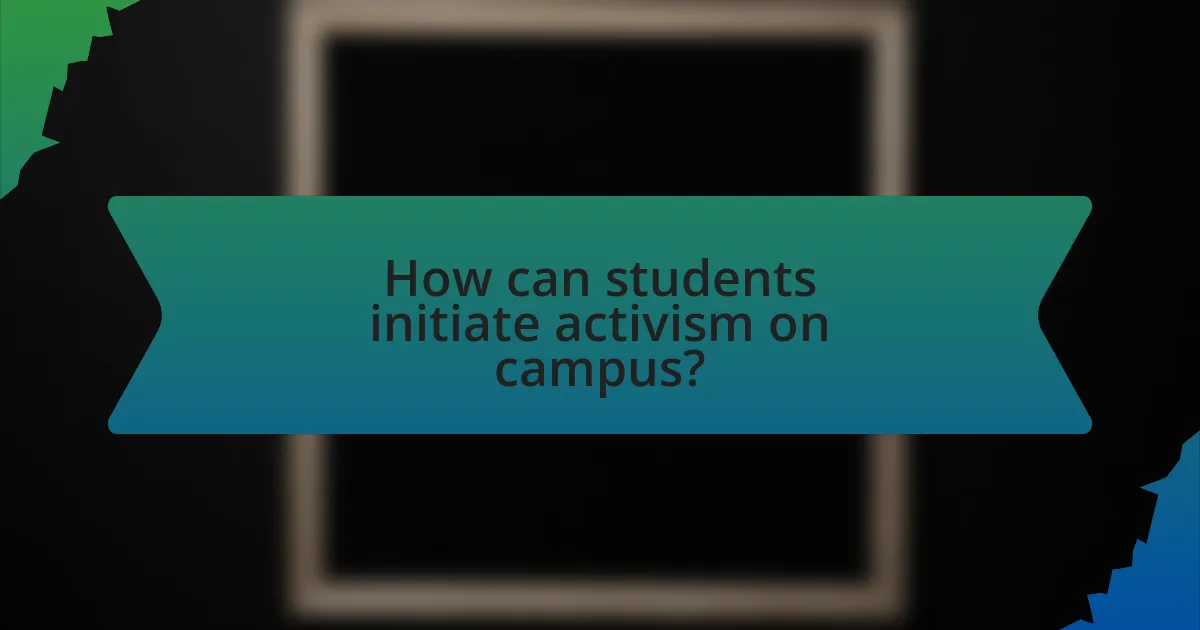
How can students initiate activism on campus?
Students can initiate activism on campus by organizing events, forming student organizations, and collaborating with existing groups to address social issues. For instance, they can host workshops, rallies, or discussions that raise awareness about specific causes, such as climate change or social justice. Research indicates that student-led initiatives can significantly impact campus culture and community engagement, as seen in the rise of movements like the March for Our Lives, which mobilized students nationwide for gun control advocacy. By leveraging social media platforms, students can amplify their messages and connect with a broader audience, further enhancing their activism efforts.
What steps should students take to start an activist movement?
Students should begin an activist movement by identifying a specific issue they are passionate about and conducting thorough research on it. This foundational step ensures that students understand the context, history, and current landscape of the issue, which is crucial for effective advocacy. For instance, the Civil Rights Movement in the United States was driven by a clear focus on racial equality, supported by extensive research and grassroots organizing.
Next, students should build a coalition by connecting with like-minded peers and organizations on campus. This collaboration amplifies their efforts and fosters a sense of community. Historical examples, such as the anti-apartheid movement, demonstrate how collective action can lead to significant change.
After forming a coalition, students should create a strategic plan outlining their goals, tactics, and timeline. This plan should include specific actions, such as organizing events, campaigns, or petitions, which can mobilize support and raise awareness. The Women’s March in 2017 serves as a powerful example of how strategic planning can galvanize large numbers of participants around a common cause.
Finally, students should engage with the broader community and utilize social media to spread their message and gain traction. Effective use of platforms like Twitter and Instagram can help reach a wider audience, as seen in the #MeToo movement, which gained global attention through social media engagement.
How can students identify pressing issues on campus?
Students can identify pressing issues on campus by engaging in active observation and participation in campus life. This includes attending student government meetings, joining clubs, and participating in discussions that highlight student concerns. Surveys conducted by organizations like the National Student Association indicate that students often report issues such as mental health resources, diversity and inclusion, and campus safety as significant concerns. By analyzing feedback from these activities and utilizing platforms for anonymous reporting, students can effectively pinpoint and prioritize the most pressing issues affecting their community.
What strategies can be employed to gather support?
To gather support for fostering a culture of activism on campus, organizations can employ strategies such as building coalitions, utilizing social media, and hosting inclusive events. Building coalitions with diverse student groups enhances outreach and creates a unified front, as evidenced by the success of initiatives like the United Students Against Sweatshops, which mobilized various campus organizations to advocate for labor rights. Utilizing social media platforms effectively allows for rapid dissemination of information and engagement with a broader audience; studies show that campaigns leveraging social media can increase participation by up to 50%. Hosting inclusive events that invite dialogue and participation from all students fosters a sense of belonging and community, which is crucial for sustained activism, as demonstrated by the success of campus forums that encourage open discussions on social issues.
How can collaboration enhance activism efforts?
Collaboration enhances activism efforts by pooling resources, skills, and networks, which increases the overall impact of initiatives. When diverse groups unite, they can leverage each other’s strengths, such as combining knowledge, outreach capabilities, and funding sources, leading to more effective campaigns. For instance, the collaboration between environmental organizations and student groups has historically resulted in larger mobilizations, as seen in the Global Climate Strikes, where millions participated worldwide due to coordinated efforts. This collective action amplifies voices, raises awareness, and fosters a sense of community, ultimately driving social change more effectively than isolated efforts.
What partnerships can be formed with local organizations?
Partnerships that can be formed with local organizations include collaborations with non-profits, community service groups, local businesses, and educational institutions. These partnerships can enhance campus activism by providing resources, expertise, and opportunities for students to engage in community issues. For instance, partnering with non-profits can facilitate volunteer opportunities and awareness campaigns, while local businesses may offer sponsorships or internships that align with activist goals. Educational institutions can collaborate on research projects or joint events that promote social justice and civic engagement, thereby fostering a culture of activism on campus.
How can students engage with diverse campus groups?
Students can engage with diverse campus groups by actively participating in events, joining organizations, and collaborating on initiatives that promote inclusivity. Engaging in events such as cultural festivals, workshops, and discussions allows students to learn about different perspectives and experiences. Joining student organizations that focus on various cultural, social, or political issues fosters connections with peers from diverse backgrounds. Additionally, collaborating on initiatives, such as community service projects or advocacy campaigns, encourages teamwork and understanding among students from different groups, thereby enhancing the campus culture of activism.
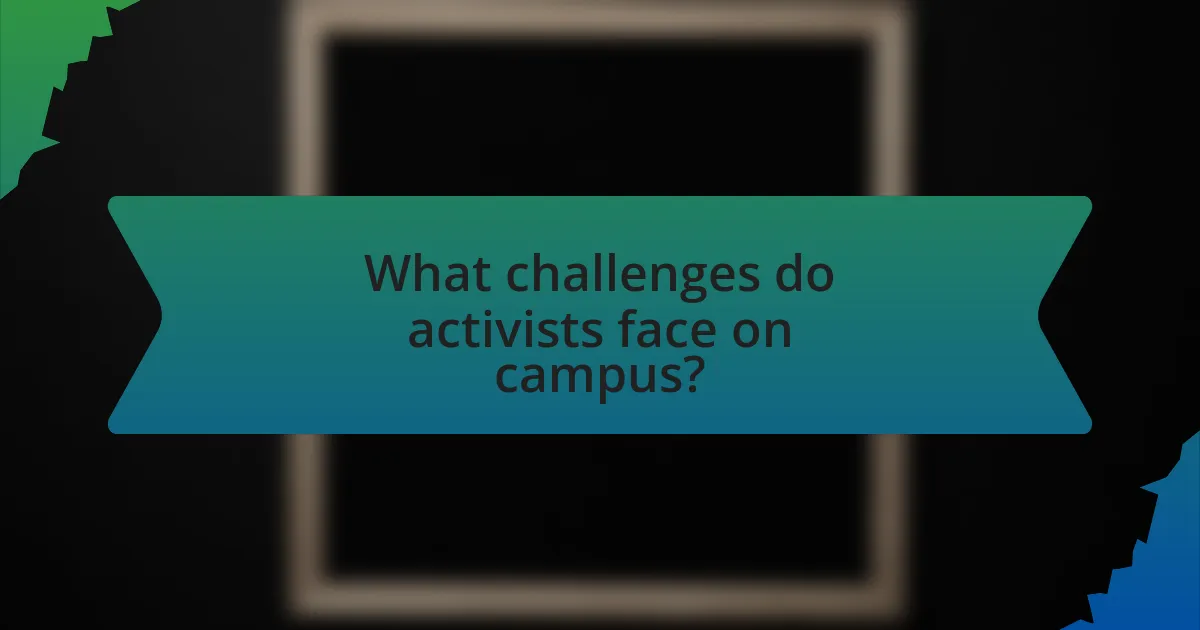
What challenges do activists face on campus?
Activists face several challenges on campus, including administrative resistance, lack of funding, and student apathy. Administrative resistance often manifests as bureaucratic hurdles that hinder the organization of events or initiatives, limiting activists’ ability to mobilize support. Lack of funding restricts the resources available for campaigns, making it difficult to effectively promote causes or reach a wider audience. Additionally, student apathy can pose a significant barrier, as many students may be disengaged or indifferent to social issues, resulting in low participation in activist efforts. These challenges collectively impede the effectiveness of activism on campus.
What are common obstacles to fostering activism?
Common obstacles to fostering activism include lack of awareness, limited resources, and institutional resistance. Lack of awareness occurs when individuals are uninformed about social issues or the importance of activism, which can hinder participation. Limited resources, such as funding, space for events, and access to information, restrict the ability of groups to organize effectively. Institutional resistance manifests when universities or organizations impose policies that limit free speech or discourage activism, creating an environment that stifles engagement. These factors collectively impede the development of a vibrant activist culture on campus.
How can activists address apathy among peers?
Activists can address apathy among peers by engaging them through relatable storytelling and interactive discussions that highlight the relevance of social issues. Research indicates that personal narratives can significantly increase empathy and motivation to act; for instance, a study published in the Journal of Personality and Social Psychology found that stories can effectively change attitudes and inspire action. By creating a connection between the issues and their peers’ experiences, activists can foster a sense of urgency and responsibility, encouraging participation in activism.
What legal or administrative barriers might activists encounter?
Activists may encounter legal or administrative barriers such as restrictive campus policies, lack of access to resources, and potential legal repercussions for protests or demonstrations. For instance, many universities have regulations that limit the times and locations where protests can occur, which can hinder activists’ ability to organize effectively. Additionally, activists may face challenges in obtaining permits for events, which can be complicated by bureaucratic processes. Legal repercussions can arise from violations of these policies, leading to disciplinary actions against students involved in activism. These barriers can significantly impede the ability of activists to mobilize and advocate for change on campus.
How can activists overcome these challenges?
Activists can overcome challenges by building strong coalitions and utilizing effective communication strategies. Forming alliances with diverse groups enhances resource sharing and amplifies voices, making it easier to address issues collectively. For instance, research shows that collaborative efforts in activism can lead to a 30% increase in campaign effectiveness, as seen in the success of the 2017 Women’s March, which united various organizations and demographics. Additionally, leveraging social media platforms allows activists to reach wider audiences quickly, facilitating rapid mobilization and awareness. By combining these strategies, activists can effectively navigate obstacles and foster a vibrant culture of activism on campus.
What resources are available to support campus activism?
Campus activism is supported by various resources including student organizations, funding opportunities, training programs, and access to legal assistance. Student organizations, such as activist clubs and coalitions, provide a platform for collaboration and mobilization. Funding opportunities from university grants or external organizations enable activists to finance events and initiatives. Training programs offered by universities or non-profits equip students with skills in advocacy, organizing, and public speaking. Additionally, access to legal assistance ensures that activists understand their rights and can navigate potential legal challenges. These resources collectively empower students to engage effectively in activism on campus.
How can activists build resilience in their movements?
Activists can build resilience in their movements by fostering strong community networks and encouraging adaptive strategies. Strong community networks provide emotional support, resources, and shared knowledge, which are essential during challenging times. For instance, the Black Lives Matter movement has demonstrated resilience through local chapters that mobilize support and resources, allowing for sustained activism despite external pressures. Additionally, adaptive strategies, such as flexible planning and continuous learning from past experiences, enable movements to respond effectively to changing circumstances. Research indicates that movements that prioritize community engagement and adaptability are more likely to endure and achieve their goals, as seen in various successful social movements throughout history.
What practical tips can enhance activism on campus?
To enhance activism on campus, students should organize collaborative events that engage diverse groups and promote awareness of social issues. Collaborative events, such as workshops, panel discussions, and community service projects, foster inclusivity and encourage participation from various student demographics. Research indicates that campuses with active student organizations and events see a higher level of engagement in social causes, as these activities create a sense of community and shared purpose among students. Additionally, utilizing social media platforms effectively can amplify outreach efforts, allowing for broader dissemination of information and mobilization of support for causes.
How can effective communication strategies be developed?
Effective communication strategies can be developed by identifying clear objectives, understanding the audience, and utilizing appropriate channels. Establishing specific goals ensures that the communication is purposeful, while analyzing the audience’s demographics and preferences allows for tailored messaging. Research indicates that using multiple communication channels, such as social media, emails, and face-to-face interactions, enhances engagement and information retention. For instance, a study by the Pew Research Center found that 72% of adults use social media, highlighting its effectiveness in reaching diverse groups. By combining these elements, organizations can create impactful communication strategies that resonate with their target audience.
What role does social media play in modern campus activism?
Social media serves as a crucial platform for modern campus activism by facilitating communication, mobilization, and awareness among students. It enables activists to quickly disseminate information, organize events, and rally support for various causes, significantly enhancing their reach and impact. For instance, the #BlackLivesMatter movement gained momentum on college campuses through social media, allowing students to share experiences, coordinate protests, and engage a broader audience. Research indicates that 88% of young activists use social media to promote their causes, demonstrating its effectiveness in fostering a culture of activism.
